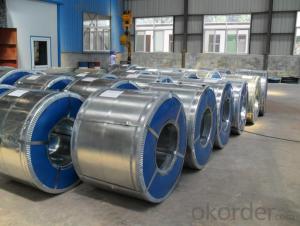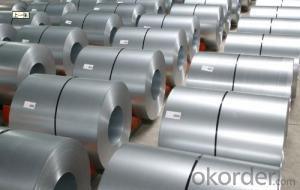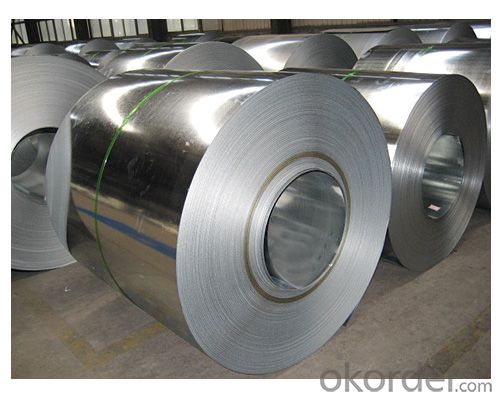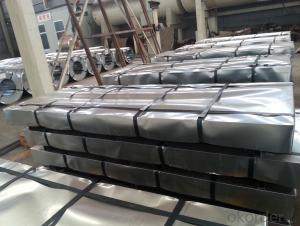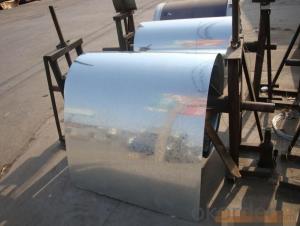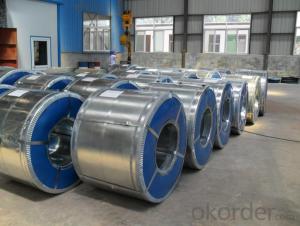Hot dip galvanized steel coil and sheet
- Loading Port:
- China Main Port
- Payment Terms:
- TT OR LC
- Min Order Qty:
- -
- Supply Capability:
- -
OKorder Service Pledge
OKorder Financial Service
You Might Also Like
Commodity | Hot dip galvanized steel coil and sheet |
Technical Standard: | JIS 3302 / ASTM A653 / EN10143 |
Grade | DX51D / DX52D/ DX53D/ S250,280,320GD |
Types: | Commercial / Drawing / Deep Drawing / Structural quality |
Width | 500/650/726/820/914/1000/1200/1219/1220/1250mm |
Thickness | 0.12-2.8mm |
Type of coating: | Galvanized |
Zinc coating | Z30-275g/m2 |
Surface Treatment | Chromed / Skin-pass/ Oiled/Slightly Oiled/ Dry/ Anti-fingerprint |
Surface structure: | Zero spangle / minimized spangle / regular spangle/ big spangle |
ID coil | 508mm or 610mm |
Coil weight | 3-8 MT per coil |
Package: | Properly packed for ocean freight exportation in 20''containers |
Application: | Industrial panels, roofing and siding for painting |
Price terms | FOB,CFR,CIF |
Payment terms | T/T or L/C |
Delivery time | Within 30 days |
Remarks | Insurance is all risks |
MTC will be handed on with shipping documents | |
We accept the third party certification test,such as SGS/BV |
Technicaldata :
Hot dipped galvanized coil Technical Data
Chemical Composition | ||||||
GRADE | C | Si | Mn | P | S | Ti |
SGCC/DX51D+Z | ≤0.10 | ≤0.50 | ≤0.60 | ≤0.10 | ≤0.030 | ≤0.020 |
DX52D+Z | ≤0.10 | ≤0.50 | ≤0.60 | ≤0.10 | ≤0.030 | ≤0.020 |
SGCD/DX53D+Z | ≤0.10 | ≤0.30 | ≤0.50 | ≤0.05 | ≤0.030 | ≤0.020 |
SGCE/DX54D+Z | ≤0.10 | ≤0.30 | ≤0.30 | ≤0.03 | ≤0.020 | ≤0.020 |
DX56D+Z | ≤0.10 | ≤0.30 | ≤0.30 | ≤0.03 | ≤0.020 | ≤0.020 |
Structural | ≤0.20 | ≤0.60 | ≤1.70 | ≤0.10 | ≤0.045 | |
|
|
|
|
|
| |
Hot dipped galvanized steel coil Mechanical Properties | |||
GRADE | Yield Strength MPa | Tensile Strength MPa | Elongation % |
SGCC(DX51D+Z) | ≥205 | ≥270 | - |
SGCD(DX53D+Z) | - | ≥270 | 38 |
SGCE(DX54D+Z) | - | ≥270 | 40 |
DX56D+Z | - | ≥270 | 42 |
- Q: How do steel coil manufacturers stay updated with industry trends?
- Steel coil manufacturers stay updated with industry trends by regularly attending industry conferences, trade shows, and seminars where they can network with other professionals and learn about the latest advancements and innovations in the steel coil industry. They also subscribe to industry publications, join professional associations, and participate in online forums and webinars to stay informed about market trends, new technologies, and industry best practices. Additionally, they actively engage with their customers and suppliers to gather feedback and insights, allowing them to adapt and stay ahead of the curve in this rapidly evolving industry.
- Q: Yes, I understand it can weaken steel greatly. But can it MELT steel? (key word: melt)
- Jet fuel is kerosene in 6 grades and highly filtered. can it melt or weaken steel? No, it preserves it.
- Q: what is the chemical process that makes steel harder when it is heated and cooled rapidly?what does the heating of it do to the atoms?what does the cooling of it do to the atoms?what makes tempered steel so strong compared to untempered steel?
- You can't temper all steels. Generally the material must be a high-carbon or tool steel. Different alloys temper differently, and tempering is usually done to get a specific set of characteristics, so you must know what you are working with and use the right methods and temperature. If you do it wrong, the material may be hard but too brittle for the purpose or have other issues. It can be simple, such as heating to a dull red, carbonizing the surface (use an acetylene rich flame until it blackens the surface) and oil quenching. Do that to a piece of tool steel (like a screwdriver) and it will case (surface) harden it to the point you can't scratch it with a file. Tempering changes the way the molecular structure in the metal is linked and oriented.
- Q: How are steel coils used in the production of industrial boilers?
- Steel coils are used in the production of industrial boilers to form the main body and components of the boiler, such as the shell, tubes, and headers. The coils are shaped and welded together to create a strong and durable structure that can withstand high pressure and temperature conditions. Additionally, the use of steel coils ensures the boiler's efficiency and longevity, as steel is known for its excellent heat transfer properties and resistance to corrosion.
- Q: What are the different methods of levelling steel coils?
- There are several methods used for leveling steel coils, depending on the specific requirements and applications. Some of the common methods include: 1. Roller Leveling: This method involves passing the steel coil through a series of rollers that exert pressure on the material, effectively reducing any residual stresses and removing any waviness or curvature. Roller leveling is commonly used for thinner gauge coils where a high degree of flatness is desired. 2. Stretch Leveling: This method involves stretching the steel coil beyond its yield point to eliminate any shape defects. The coil is subjected to tension in a stretcher leveler machine, which elongates the material and removes the inherent stresses. Stretch leveling is often used for thicker gauge coils where a higher degree of flatness is required. 3. Temper Milling: This method involves passing the steel coil through a temper mill, which is a cold reduction mill equipped with work rolls on top and bottom. The temper mill imparts tension on the coil, flattening it and improving its shape and surface quality. This method is typically used for higher strength steel grades. 4. Corrective Leveling: This method is employed when the steel coil has significant shape defects, such as wavy edges or center buckles. Corrective leveling involves selectively removing material from specific areas of the coil to achieve a flat and uniform surface. This process is often done using laser or plasma cutting machines. 5. Tension Leveling: This method is similar to stretch leveling, but it involves applying tension to the coil without exceeding its yield point. Tension leveling utilizes a series of bridle rolls to stretch the material, thereby removing any internal stresses and leveling the coil. This method is commonly used for higher strength and thinner gauge coils. These methods can be used individually or in combination depending on the specific requirements of the steel coil and the desired end product. Each method has its advantages and limitations, and the choice of leveling method will depend on factors such as the coil thickness, material properties, and desired flatness.
- Q: What are the different methods of coil leveling?
- Various industries commonly utilize several methods for coil leveling. These methods encompass: 1. Roller leveling: By passing the coil through a sequence of rollers, pressure is applied gradually, resulting in the gradual flattening of the coil. The rollers can be adjusted to exert varying levels of pressure, allowing for precise control over the leveling process. 2. Stretch leveling: This technique subjects the coil to tension forces, elongating the material and eliminating internal stresses. As the coil is stretched while passing through rollers, a more uniform and flat surface is achieved. 3. Temper leveling: Involving the heating of the coil to a specific temperature followed by rapid cooling, this method helps equalize stresses within the coil and enhance its flatness. Temper leveling is often employed for high-strength steels. 4. Roller leveling with leveling rolls: This approach utilizes additional leveling rolls placed above and below the main leveling rollers. These rolls apply pressure to specific areas of the coil, rectifying any unevenness or distortions. 5. Tension leveling: This method involves applying tension to the coil during processing. The tension aids in straightening and flattening the material, resulting in a more even and flat surface. 6. Precision leveling: Employed for high-precision applications necessitating extremely flat and uniform coils, precision leveling combines roller leveling, stretch leveling, and other corrective measures to attain the desired flatness. Each of these methods possesses unique advantages and limitations. The selection of a particular method depends on factors such as the type of material being leveled, the required flatness tolerance, and the intended application of the coil.
- Q: How are steel coils used in the manufacturing of tubes?
- Steel coils are commonly used in the manufacturing of tubes as they provide a continuous and uniform supply of high-quality steel material. These coils are processed through various stages, including slitting, forming, and welding, to create tubes of different sizes and shapes. The steel coils are unrolled, cut into strips, and then formed into a cylindrical shape. The edges of the strips are welded together to create a seamless tube. This process ensures the production of strong and reliable tubes that are widely used in industries such as construction, automotive, and manufacturing.
- Q: How do steel coil manufacturers handle custom orders?
- Steel coil manufacturers handle custom orders by following a systematic process that involves understanding the specific requirements of the customer, designing and producing the custom coils, and ensuring quality control throughout the manufacturing process. Firstly, when receiving a custom order, manufacturers must thoroughly understand the customer's specific needs. This involves detailed communication and collaboration with the customer to gather information about the desired specifications, dimensions, tolerances, and other special requirements. Manufacturers may also provide technical expertise and guidance to the customer to ensure that the custom order can be successfully produced. Once the requirements are clearly defined, manufacturers proceed with designing and engineering the custom steel coils. This involves utilizing advanced software and engineering tools to create detailed designs and specifications that meet the customer's unique needs. Manufacturers may also create prototypes or samples for the customer's approval before proceeding with full-scale production. After the design phase, manufacturers begin the production process. This typically involves sourcing the appropriate raw materials, such as steel coils of the required composition and thickness. The coils are then processed through various manufacturing stages, including cutting, shaping, and forming, to achieve the desired dimensions and shapes. Specialized equipment and machinery are used to ensure precision and accuracy throughout the production process. Quality control is a crucial aspect of handling custom orders. Manufacturers conduct rigorous inspections and testing procedures at various stages of production to ensure that the custom coils meet the customer's specifications and industry standards. This includes checking for dimensional accuracy, surface finish, mechanical properties, and any other specific requirements set by the customer. Manufacturers may also involve third-party inspection agencies or provide customers with test reports and certifications for quality assurance. Finally, once the custom steel coils are manufactured and pass all quality checks, they are carefully packaged and delivered to the customer. Manufacturers ensure proper packaging and shipping methods to prevent any damage during transit and ensure the coils reach the customer in optimal condition. In summary, steel coil manufacturers handle custom orders by closely collaborating with customers, designing and engineering specialized coils, ensuring quality control throughout the production process, and delivering the custom coils to the customer's satisfaction. This systematic approach allows manufacturers to meet the unique requirements of each customer and deliver high-quality custom steel coils.
- Q: which elements are alloyed to make stainless steel?A Fe, CB Fe, MnC Fe, NiD Fe, CrE Fe, Cr, Ni
- E. Stainless steel is mainly comprised of Cr and Ni. Steel is an alloy composed mainly of iron. On a side note, Carbon is not really in stainless steel and it is only less than .1%
- Q: Does aluminum or steel hold up better? We found a steel for 1/2 the price of aluminum, obviously its heavier but any other downsides? rust faster ect? also, does anybody know, in PA do you pay sales tax on trailers? and do dealers normally give you license plates to get the trailer home with? we live 3 hours away from the dealer so thats why i want all details :) would stink if i messed up!!
- I have a steel trailer. It's okay but I think next time I'll go for aluminum because mine is rusting, particularly on the tongue, so the hitch gets all frozen up. Drives me nuts. Yeah, you pay sales tax on trailers and the dealership SHOULD give you temporary plates to get home, just like they do on vehicles.
Send your message to us
Hot dip galvanized steel coil and sheet
- Loading Port:
- China Main Port
- Payment Terms:
- TT OR LC
- Min Order Qty:
- -
- Supply Capability:
- -
OKorder Service Pledge
OKorder Financial Service
Similar products
Hot products
Hot Searches
Related keywords
